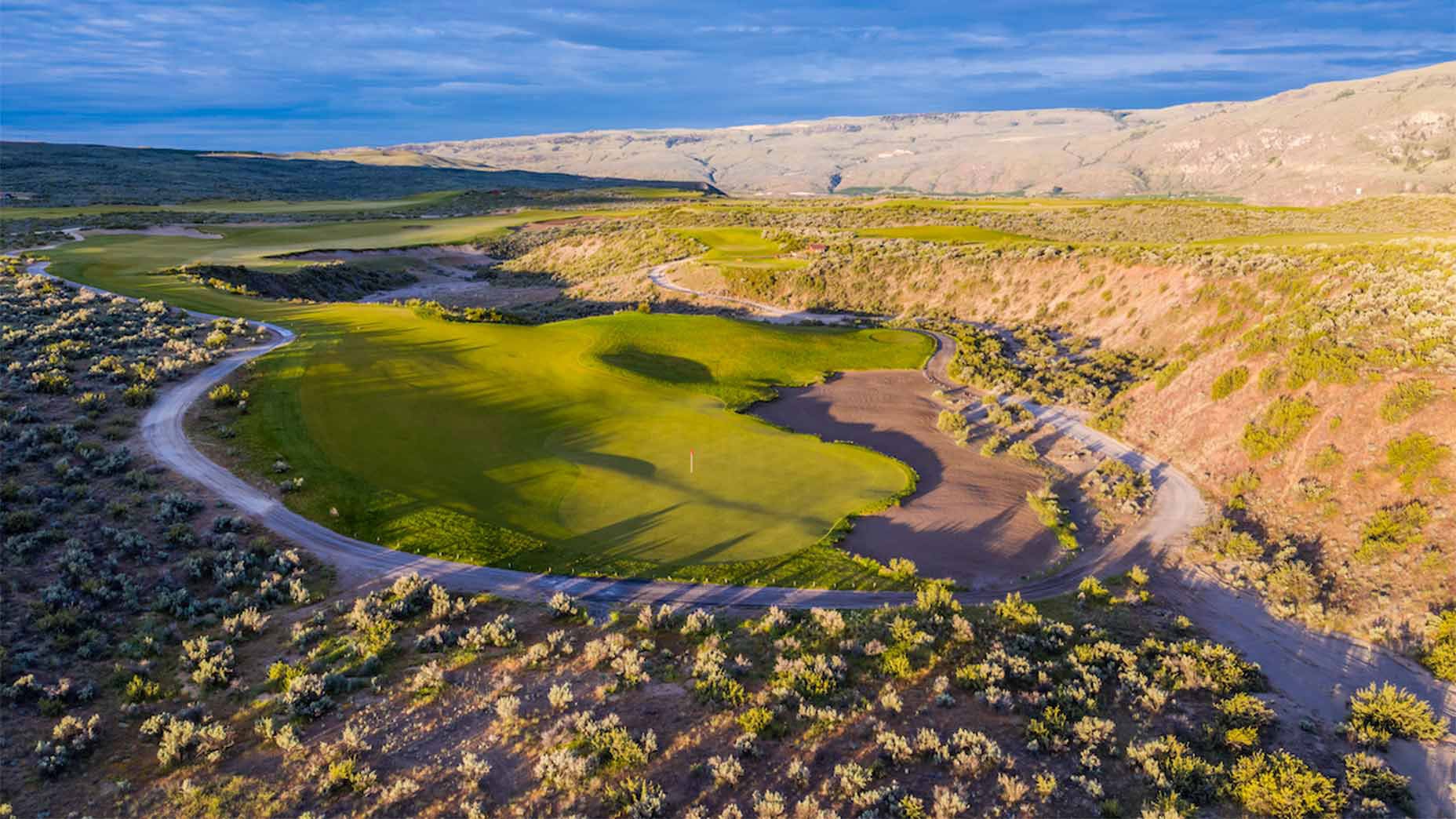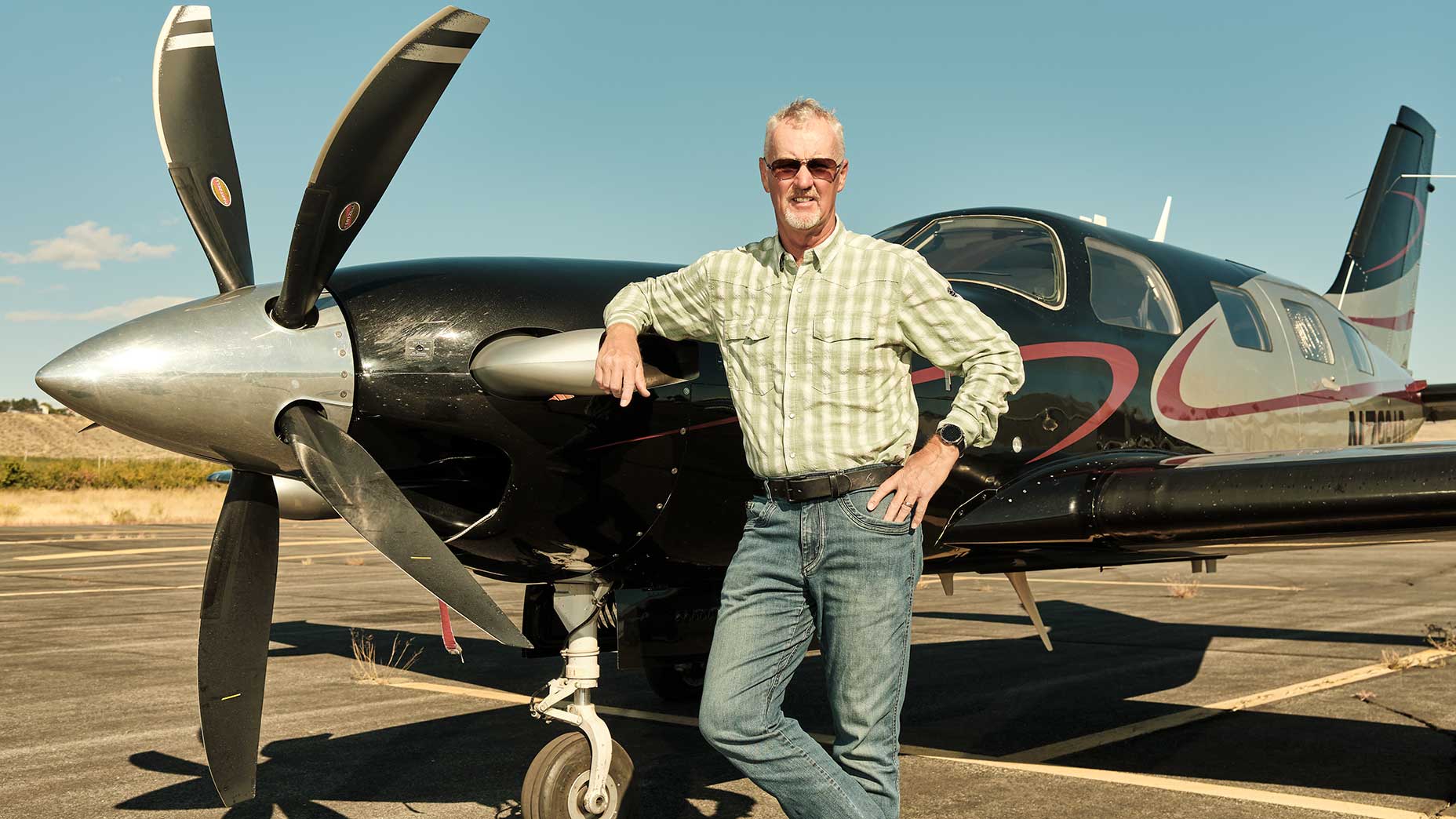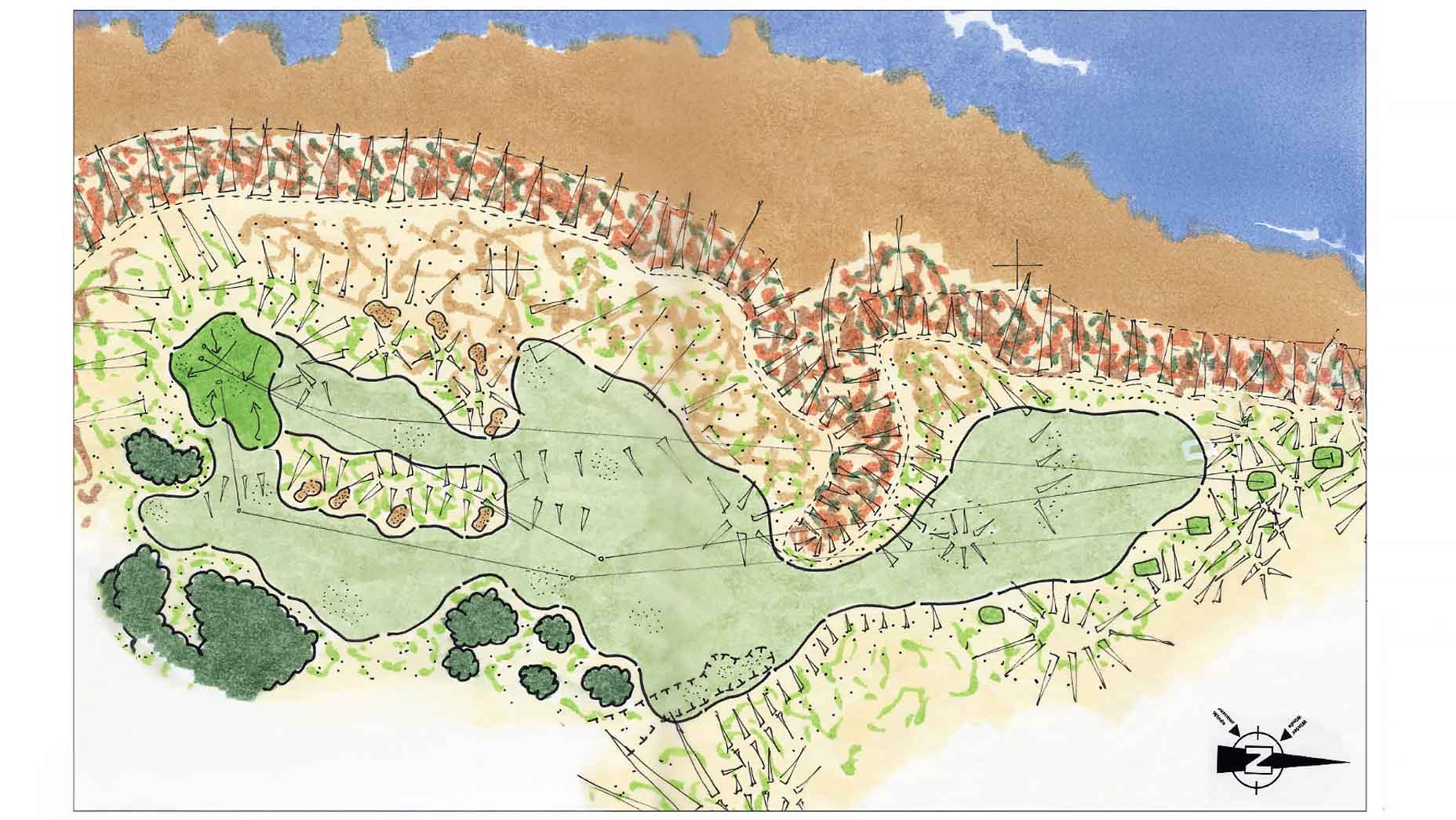It’s a wind-whipped afternoon in in the Nebraska Sandhills, and David McLay Kidd has a challenging approach, dead into a gale to a rock-hard target that leaves little room for error. On the courses he creates, McLay Kidd likes giving golfers options, but in this situation there is only one angle of attack. Perched in the cockpit of his Piper M600, descending from an altitude of 30,000 feet, the celebrated architect locks in his line. Visibility is clear, with fierce gusts out of the south. An airstrip stretches into view and McLay Kidd banks the Piper toward it. The small plane shakes, fighting the fan.
“If these were crosswinds, I wouldn’t even be attempting this,” McLay Kidd says. “Nobody needs an adventurous pilot. You want a boring pilot who follows all the rules.”
Aviation, though, is unlike architecture. And in the field that made him famous, dull conformity has never been McLay Kidd’s thing. His aversion to playing it safe has been apparent since the 1990s, when he rocketed to renown for his work at Bandon Dunes, on the Oregon coast. If the course was an outlier — a rugged, remote links in an age of lushly kept, centrally located layouts — so was its designer, a twentysomething Scotsman plucked from obscurity for the job.
In the 25 years since it opened, Bandon Dunes has been a Top 100 fixture and the most played course at the resort that has grown around it. Yet the best measure of its import might not be its popularity or its place in the rankings. In the eyes of many experts, McLay Kidd’s work represents a crucial pivot point in golf development, a before-and-after line in the industry sand.
“These days, we take destination golf for granted,” says Ran Morrissett, architecture editor for GOLF. “But it’s fair to say that if the first course at Bandon Dunes had not been such a success, there might never have been a Sand Valley or a Streamsong or a Barnbougle Dunes.”
McLay Kidd’s career might not have taken off, either. Instead, it shot into the stratosphere, propelled by headline commissions in Hawaii, England, South Africa and beyond.
As with most high-flying rides, there were bumps. In the buzzy wake of Bandon, turbulence in his personal and professional life prompted McLay Kidd to reassess his approach to both. He quit drinking. And after pushing the envelope on a pair of prominent designs that critics deemed too penal for the average player, he came to the soul-searching conclusion that his best path forward was through his recent past.
“I did a lot of hard thinking,” he says. “And what I realized was that I needed to get back to what had guided me at Bandon and the qualities that made that course so universally loved.”
Browse GOLF’s latest Top 100 Courses in the U.S. ranking here. And to listen to our ratings experts break down the list, check out our all-new travel podcast Destination GOLF. Listen and subscribe wherever you get your podcasts: APPLE | SPOTIFY | IHEART | AMAZON
Pressing refresh helped return McLay Kidd to the top of his game and kept him top of mind for anyone looking to build a marquee course, a position he retains today. When calls go out for plum assignments, he’s among the first who hears a ring.
His calendar is jammed. As of the latest count, DMK Golf Design, his firm based in Bend, Ore., has 14 projects in various stages of development, from Florida to Cabo to the Coachella Valley. These include the sixth 18-hole course at Bandon Dunes, which McLay Kidd has routed roughly 30 minutes down the coast from the main resort, and a soon-to-open sibling layout to his Top 100 course at Gamble Sands, in eastern Washington State.
Such commitments call for relentless travel, and though McLay Kidd isn’t alone among his peers in logging round-the-world air miles, he’s the only A-list architect who pilots his own plane. The pleasure is visceral.
“The freedom to jump across a mountain at high speed on your own schedule — who wouldn’t want that?” he says.
But above all, the choice of transport is pragmatic. Still burningly ambitious at 56, McLay Kidd has also learned the benefits of balance, and having a jet at his disposal is the quickest and easiest way in and out of Bend, where he lives with his wife, Tara, and their two young kids.
On this afternoon, it’s taken barely four hours to make it from his doorstep to touchdown in central-west Nebraska, where he’s come to mark the opening of his newest course, GrayBull, a richly entertaining design built on heaving, sandy land. Taxiing to a stop, McLay Kidd kills the engine, pops the hatch and slides behind the wheel of a waiting car.
“Traveling like this lets me spend more time at home and more time on-site,” he says. “It’s also a lot more fun in between.”

Almost any place he goes these days, McLay Kidd is a long way from where he started. His childhood wasn’t Dickens, but it also wasn’t Downton Abbey. The elder of two kids born to working-class high school sweethearts, he spent his youngest years on the rough-edged west side of Glasgow, where his father, Jimmy, worked as the underpaid greenskeeper at a local club. The family home was a centuries-old stone cottage that his parents heated by coal-fired hearth.
As he recalls it, McLay Kidd didn’t think of his family as poor, and, even if he had, he says, it wouldn’t have mattered. His was a happy, outdoorsy upbringing. When he wasn’t in school, he shadowed his dad, pitching in on course maintenance, just as he helped on the weekends when Jimmy worked a side gig tending to neighborhood gardens and lawns.
“Years later, I remember my dad telling me that he knew that there were really only three things he could give me: confidence, self-respect and a work ethic,” McLay Kidd says. “He was almost apologetic to the point where it upset me. I told him, ‘There is nothing to be sorry about. You gave me everything I could have ever needed.'”
There was more to come. By the time McLay Kidd reached high school, Jimmy had risen to a prestigious post as head greenskeeper at Gleneagles. To the extent that he’d plotted his own future, McLay Kidd had always figured that he’d find it in golf, most likely by following in his father’s footsteps. But while majoring in “land sciences” at England’s Writtle College, his thinking shifted after his dad connected him with a summer internship on a nearby golf course project being built by a well-known former player.
“Except that former player wasn’t doing the work that really mattered,” McLay Kidd says. “All the important decisions were being made in the field. I realized that’s where the action was. And that’s where I wanted to be.”
After graduation, he apprenticed for the British architect Howard Swan before another opportunity presented itself. Gleneagles had been acquired by the beverage behemoth Diageo, whose honchos were looking for a go-getter to help them expand their golf and hospitality holdings. Here again, paternal connections didn’t hurt. With his dad as a conduit, McLay Kidd assumed a role with Gleneagles Golf Development, traveling the globe in search of promising sites.
“And so that’s how I spent the better part of my twenties,” he says. “Helping Gleneagles with their grand plan to conquer the world through golf.”
It didn’t happen. What happened instead? A golf-mad Chicago businessman named Mike Keiser hatched a crazy scheme to build a links course on the Oregon coast.
I was getting big commissions, [and] I started thinking, This is where they’re going to realize I don’t know s–t.
To say the rest is history leaves out a lot. McLay Kidd was barely 30 when Bandon opened — an overnight star who, for all his outward self-assurance, worried that he might become a one-hit wonder. Offers poured in from heavy hitters. In short order, McLay Kidd signed on to build a course for the bigwig businessman Fred Green, in England, and another for Charles Schwab in Hawaii. While those and other projects received raves — Nanea, on the Big Island, debuted at No. 76 on GOLF’s list of the Top 100 Courses in the World and holds a place today at No. 83 on our Top 100 Courses in the U.S. — McLay Kidd suffered from impostor syndrome.
“I was getting big commissions, but the sites were not as good [as Bandon], and the expectations were higher,” he says. “I started thinking, This is where they’re going to realize I don’t know s–t.”
Feeling pressure to outdo himself, the architect moved toward more audacious terrain. Two strikingly bold statements were Tetherow (2006), in Bend, and the Castle Course (2008), in St. Andrews, a bright spotlight of a project for the St. Andrews Links Trust, just up the road from the Old Course. Both designs proved polarizing — praised by many for their creativity but also seized upon by critics who found them over-cooked. Of the displeased voices, none captured more attention than that of McLay Kidd’s contemporary, Tom Doak, who, in an updated version of his course-review compendium, The Confidential Guide to Golf Courses, gave the Castle Course a zero on a scale of zero to 10 — a grade reserved for layouts “so contrived [they] probably shouldn’t have been built at all.”
McLay Kidd contended at the time — and remains convinced today — that the zero was borne in part out of a personal grievance dating back to the early days of Bandon Dunes, where both architects had been in the running to build the resort’s inaugural course before Keiser went with McLay Kidd.
“Whether Tom would be willing to acknowledge it or not, I think he always felt that I had been dropped on the mountain-top while he had to work hard to get to the summit,” McLay Kidd says. “And that bothered him.”
Doak, for his part, has repeatedly maintained that he was passing judgment only on the Castle Course’s design merits. Whatever the case, McLay Kidd says the two have set aside any differences, and if the zero ever stung, he now treats it with a shrug. It helps that he’s more at peace than ever in his life.
“I’ve realized,” he says, “that I don’t have to go about my days with clenched fists.”

That’s not difficult to do at a place like GrayBull, an unbuttoned but exclusive redoubt — barefoot golf for the high-finance set — where McLay Kidd will spend the next day and a half dining on wagyu beef and whacking the ball around. Despite its heartland surrounds, the course abides by the links-golf principles on which McLay Kidd cut his teeth. Its rollicking fairways are wide enough that it’s hard to lose a ball. The tougher part is finding the right angles. Dead-aim aerial assaults aren’t often the smart choice, and leaning on power alone can lead to trouble. Better to contemplate the many ground-game options to targets best attacked by way of friendly contours and bouncy corridors.
It’s good, clean fun, and McLay Kidd is having plenty of it. But given the rhythms of his work, it’s rarely long before there’s somewhere he needs to be. Two mornings later, just after sunrise, he is back in the cockpit, winging west above the clouds, his Piper set on autopilot. Though it would never be mistaken for a luxury jetliner, the turboprop is plenty of plane. Not for nothing is the price tag for a new one $4.3 million.
Sometimes, when he’s breezing from here to there — over the past 12 months, he has taken the Piper on 84 trips, totaling 70,000 miles — McLay Kidd marvels at the differences between then and now; how, for instance, the total construction costs of Bandon Dunes were lower than the price of the plane he flies today. There is more money than ever in the game’s upper reaches, and business is good for top architects, with negotiations for design fees routinely starting in the seven figures. It’s more than a nice living. Yet those fat sums aren’t what fully butter McLay Kidd’s bread. Since 2001, he has also run his own construction company, which serves as general contractor for many of the courses he builds.
“That’s what pays for the jet,” he says.
As it happens, McLay Kidd needs to check in on one of those projects. Opening his laptop, he boots up a video call with his team at Loraloma, a private course-in-the-making outside Austin, Texas, and talks through the nitty-gritty of the property’s short-game complex. Another video conference follows with the head agronomist at Bandon Dunes for an update on the resort’s sixth 18-holer, tentatively named New River Dunes. Both conversations are a study in efficiency, conducted from his cockpit five miles somewhere above Montana. By the time McLay Kidd closes his computer, the Rocky Mountains are behind him and the Cascades are approaching. A stunning green valley stretches beneath him. Next stop: Brewster, Wash.
Like Bandon Dunes, Gamble Sands — No. 100 on this year’s Top 100 U.S. list — marks a watershed in McLay Kidd’s career. Completed in 2014, it was his first design after a period of introspection that returned his focus to proven fundamentals: The emphasis was once more on playability and fun. Set amid thousands of acres of apple and cherry orchards, overlooking the confluence of the Columbia and Okanogan rivers, the original course is as inviting as it is engaging, with acres of fine fescue awaiting off the tee but plenty of movement in the fairways to ensure that placement matters. The greens are large and mellow. Think easy par, hard birdie for a good player and, coupled with views, an exhilarating round regardless of your game.

If the beautiful simplicity of Gamble Sands was a kind of course correction for McLay Kidd, it was also a reminder of his gifts. Course raters were impressed. So was Mike Keiser, who, after touring Gamble Sands, added McLay Kidd to a short list of contenders for a project at Sand Valley Resort in central Wisconsin, where McLay Kidd won the bid for what would become Mammoth Dunes.
Unlike Keiser, who has mixed and matched architects in his resort expansions, the fruit-farming family behind Gamble Sands has gone all in on McLay Kidd. They brought him back to build QuickSands, a 14-hole par-3 design that was completed in 2021. And they’ve since given him a third commission: another 18-holer, set on sandy bluffs adjacent to the original. It will open to the public in 2025, but on this sun-kissed afternoon, it’s grassed in enough to play, and McLay Kidd is eager to give it a test run.
He’s joined on the first tee by Tory Wulf, an amiable, jeans-clad orchardist who doubles as project manager, and off they go, pounding drives on a friendly handshake of an opening par 4. The new course is a sibling to the Sands but not an identical twin. Though its fairways, too, are wide, its terrain is more rambunctious, bucking and rolling along ridges and rises, and building in drama as it goes.
“You should call it Twisted Sister,” McLay Kidd says, as he and Wulf walk toward their shots. He’s joking. Sorta. “It’s really going to be the wilder of the two.”
Wulf gives a noncommittal laugh. (Weeks later, Gamble Sands would announce the name of the new course: Scarecrow.) He and McLay Kidd have known each other for more than a decade, and their conversations blend biz talk and banter.
“From the day we met, I’ve known David to be a straight shooter,” Wulf says. “I also know that I can count on him being all in on what he’s doing for us. He’s as interested as we are in selling what we have.”
Call it what you will. An art. A craft. A golf course is also a product. McLay Kidd treats his work as all of the above. One of the game’s great conversationalists, he also ranks among its finest pitchmen, whether speaking with the media or a business mogul. Ultimately, though, how people view his efforts is out of his control. That is something McLay Kidd has learned to accept, especially when it comes to the rankings, though such critical assessments are less important to him than popular opinion.
“What’s pretty clear is that the rankings are not always a reflection of the courses that golfers love the most,” he says. “And if you asked me, would I rather have a high-ranked course or a course that people enjoy and want to play again and again — I’d take the latter every time.”
The afternoon is wearing on, and he and Wulf have reached the back nine and a short par 3. It plays to a green set on a bluff, framed by a valley panoramic, with the sun dipping low over a ridge in the backdrop. McLay Kidd pauses to drink in the vista. In the coming weeks, he will have to fly to Texas and then back to Gamble Sands and then to who knows where his work might call him. But his next flight will be in the direction he is staring. He’ll take off tomorrow, spend an hour in the air and be home in time to put the kids to bed.











